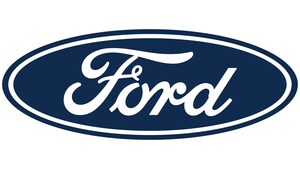Full Harvest of Ford Greener Fuel Solutions for Commercial Customers Showcased at NTEA Work Truck Show
INDIANAPOLIS, March 7, 2011 /PRNewswire/ --
- Ford offers a more comprehensive alternative-fuel solution to commercial customers than any other manufacturer
- By 2012, half of Ford vehicles will be capable of running on alternative fuels
- By 2020, Ford is targeting a 30 percent reduction in CO2 emissions from Ford vehicles in the U.S. and Europe
Ford Motor Company's (NYSE: F) ever-growing portfolio of fuel-efficient products extends to commercial customers, including those interested in alternative-fuel vehicles to "green" their fleets.
Visitors to the annual National Truck Equipment Association (NTEA) show can see firsthand how Ford delivers the most comprehensive alternative-fuel solutions for commercial customers. The wide variety of vans and trucks with alternative-fuel capability is backed by support for customers looking to switch their vehicles from gasoline power to another fuel, such as compressed natural gas or propane. By 2012, half of all Ford vehicles will be capable of running on alternative fuel.
"No other manufacturer offers the range of vehicles and alternative-fuel solutions combined with comprehensive support," said Len Deluca, director, Ford Commercial Truck. "We're bringing our commercial customers the solutions they need in this ever-competitive environment."
As businesses seek to be more environmentally responsible in all facets of their operations, greening a vehicle fleet is often a natural first step that can have an immediate and positive impact. There also are government tax credit incentives for fleets to convert to alternative fuels.
With the wide variety of requirements for commercial vehicles – such as application, payload and driving cycle – Ford has developed an expansive suite of vehicles and alternative-fuel choices.
Ford commercial truck alternative-fuel choices at a glance
Vehicle |
Transit |
E-Series |
E-Series |
E-Series |
F-Series |
F-350-F-550 |
F-650/ F-750 |
F53, F59 |
|
Flex fuel |
Yes |
Yes |
Yes |
Yes |
Yes |
||||
Biodiesel |
Yes |
Yes |
Yes |
||||||
CNG/LPG* |
Yes |
Yes |
Yes |
Yes |
Yes |
Yes |
Yes |
Yes |
|
Hybrid |
Yes |
Yes |
|||||||
Plug-in hybrid |
Yes |
||||||||
BEV** |
Yes |
Yes |
|||||||
*CNG/LPG (compressed natural gas/liquefied petroleum gas – propane or butane) capable of conversion by third-party modifier when equipped with optional prep engine **Hybrid, PHEV and BEV (battery electric vehicle) upfitted by third-party modifier |
|||||||||
"Our range of choices helps ensure customers can find the right product that best suits their needs," said Deluca.
For example, a battery electric vehicle (BEV) might be appropriate for customers with multiple short trips over the course of a day totaling less than 100 miles. CNG, LPG and flex-fuel vehicles have a range of about 300 miles before needing to be refueled. Biodiesel and hybrid vehicles stretch the range even further, up to 500 miles.
Types of fuels and their advantages
Here's a quick look at the types of fuels offered in Ford commercial trucks:
- Flex fuel: A flexible-fuel vehicle (FFV) is an alternative-fuel vehicle with an internal combustion engine designed to run on more than one fuel, usually gasoline blended with ethanol (E85), and both fuels are stored in the same common tank. Flex-fuel engines are capable of burning any proportion of the resulting blend as fuel injection and spark timing are adjusted automatically according to the actual blend detected by electronic sensors. E85 is the most common flex fuel and many Ford engines are capable of using E85
- Advantages – Ethanol/E85 is clean-burning and substantially reduces CO and CO2 emissions. Compared to gasoline, it is a higher octane, provides more horsepower and burns cooler. Corn and other cellulosic plants are readily available
- Considerations – E85 produces less energy, so 1.56 gallons of E85 takes you as far as one gallon of gasoline. Due to the increased volume required and the fact that alcohol is corrosive, fuel system components must be upgraded
- Biodiesel: Biodiesel refers to a vegetable oil or animal fat-based diesel fuel. Blends of biodiesel and conventional hydrocarbon-based diesel are products most commonly distributed for use in the retail diesel fuel marketplace. A system known as the “B” factor is used to state the amount of biodiesel in any fuel mix – 20 percent biodiesel is referred to as B20, for example
- Advantages – Biodiesel burns cleaner than petrodiesel, with reduced emissions
- Considerations – Biodiesel may be more expensive than petrodiesel, and in low temperatures may require a special additive or fuel tank heater to flow properly
- CNG (compressed natural gas): CNG is a fossil fuel substitute for gasoline or diesel. It is safer than other fuels in the event of a spill (natural gas is lighter than air, and disperses quickly when released). CNG is made by compressing natural gas, which is mainly composed of methane. It is stored and distributed in hard containers at a pressure of 2,900 to 3,600 psi. CNG is used in traditional gasoline internal combustion engines that have been modified to operate on CNG
- Advantages – CNG is an extremely clean-burning fuel and significantly reduces CO, CO2 and NOx compared to its gasoline counterpart. CNG has an octane rating of 130 and has the potential to optimize the engine’s thermodynamic efficiency by utilizing a higher compression ratio
- Considerations – CNG has slightly less energy than gasoline per unit volume and requires a larger fuel tank/container. Refueling time and infrastructure are also considerations
- LPG (liquefied petroleum gas): LPG is a flammable mixture of hydrocarbon gases, most commonly propane and butane. A powerful odorant is added so that leaks can be detected easily. As opposed to relying on foreign oil sources, approximately 90 percent of the United States’ propane supply is produced domestically. Propane is nontoxic and cannot get into the water table if there is a leak in the storage container
- Advantages – Power, acceleration, payload and cruise speed are comparable to those of an equivalent vehicle fueled with gasoline. Propane has a high octane rating of 104, in between CNG at 130 and unleaded gasoline at 87. Because it burns completely, there is less carbon buildup. Spark plugs, exhaust system and oil changes are needed less frequently
- Considerations – Because of the low vapor pressure of propane, in extremely cold conditions starting could be an issue
- Hybrid: A plug-in hybrid electric vehicle (PHEV), also known as a plug-in hybrid, is a hybrid vehicle with rechargeable batteries that can be restored to full charge by connecting a plug to an external electric power source. A PHEV shares the characteristics of both a conventional hybrid electric vehicle, having an electric motor and an internal combustion engine, and an all-electric vehicle, also having a plug to connect to the electric grid
- Advantages – Hybrids offer a greater range than electric-only vehicles and reduced tailpipe emissions. If a charging station is unavailable, the gasoline engine can provide power
- Considerations – The vehicle essentially has two powertrains. With that comes increased vehicle weight, reduced payload and towing capability
- BEV (battery electric vehicle): A BEV uses chemical energy stored in rechargeable battery packs. As with other electric vehicles, BEVs use electric motors and motor controllers instead of an internal combustion engine for propulsion. The concept utilizes onboard batteries for propulsion and recharges the batteries using the electric grid
- Advantages – Vehicles that run solely on electric power require no warm-up, run almost silently, and have excellent performance. Electric vehicles can be recharged at night when generating plants are underutilized. Electric vehicles produce zero tailpipe emissions. Even when emissions from the generating plants are factored in, electric vehicles emit less than 10 percent of the pollution of an internal combustion vehicle
- Considerations – Pure electric vehicles still have limited range – typically no more than 100 to 120 miles. Depending on the charge voltage, most vehicles have to sit overnight for a full charge
Making the switch from a gas engine to gaseous fuel
Ford has developed and tested a CNG/LPG Gaseous Engine Prep Package to be installed by preferred upfitters, who install the CNG/LPG tanks and hardware. The engine comes with hardened exhaust valves and valve seats for improved wear resistance and durability for gaseous fuel systems, and Ford engineers work with the upfit companies to ensure consistent and reliable performance.
The new engine calibration maintains engine operating limits as specified for cylinder pressures, piston temperatures and engine speed, among others. Ford maintains the engine and powertrain warranty (five years/50,000 miles) and the upfitter is responsible for the system component warranty.
Customer-focused alternative-fuel offerings
"Our expanded portfolio of commercial products that can operate on alternative fuels has been developed based on the relationships we have with our customers and a commitment to supporting their sustainability strategies," said Rob Stevens, chief engineer, Commercial Products. "Going forward, we will continue to maintain this customer-focused strategy in the development of future technologies."
About Ford Motor Company
Ford Motor Company, a global automotive industry leader based in Dearborn, Mich., manufactures or distributes automobiles across six continents. With about 164,000 employees and about 70 plants worldwide, the company's automotive brands include Ford and Lincoln. The company provides financial services through Ford Motor Credit Company. For more information regarding Ford's products, please visit www.ford.com.
SOURCE Ford Motor Company
WANT YOUR COMPANY'S NEWS FEATURED ON PRNEWSWIRE.COM?
Newsrooms &
Influencers
Digital Media
Outlets
Journalists
Opted In






Share this article